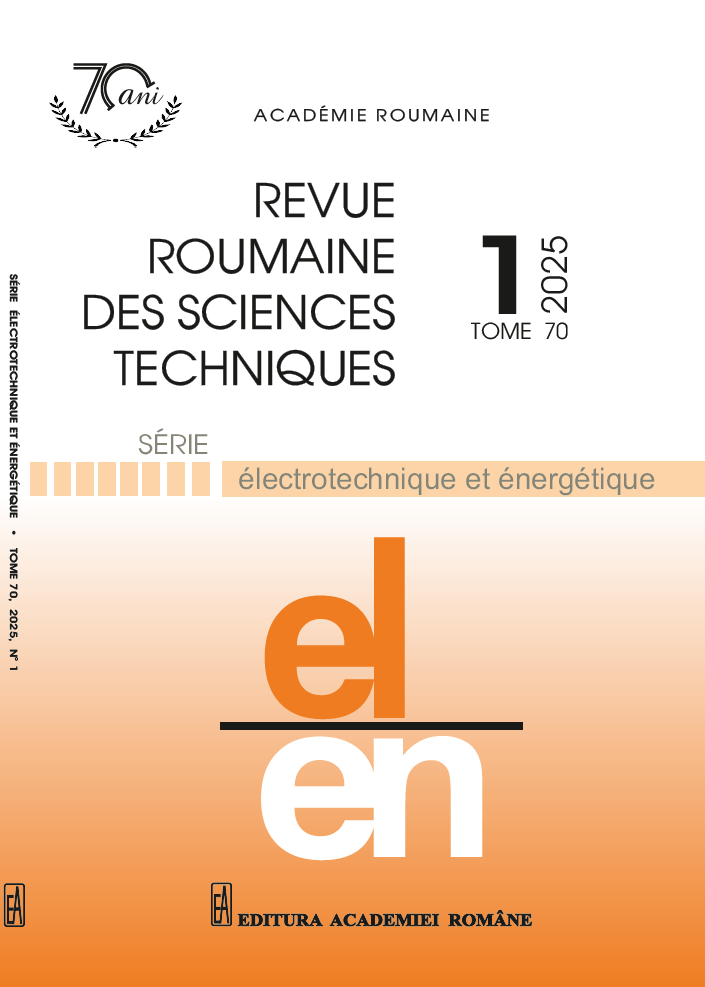ENERGY-BASED MODEL OF A LIQUID PISTON GAS COMPRESSION SYSTEM
DOI:
https://doi.org/10.59277/RRST-EE.2025.1.25Keywords:
Compressed air energy storage, Liquid piston, Port Hamiltonian system, Bond graph, Hydropneumatic accumulator, Energy-based modelAbstract
Compressed air energy storages (CAES) are used in autonomous or semi-autonomous renewable energy systems due to their advantages over battery energy storage, e.g., environmental-friendly production process and sufficiently large number of cycles. Liquid piston (LP) technology for CAES is an alternative to other gas compression technologies developed to provide better heat transfer and thus increase energy efficiency. An energy-based model of a hydropneumatic accumulator using the LP gas compression in a port-Hamiltonian (pH) form is developed for control design. The bond graph framework is utilized to directly derive the equations in the pH form by exploiting the nonlinear fluid capacitance as a storage model. Nonlinearity is depicted analytically for a generalized polytropic process considering the ideal gas condition. The operation of the developed model is validated using MATLAB R2021b Simscape simulations.
References
R. A. Rabi, J. Radulovic, J. Buick, Comprehensive review of com-pressed air energy storage (CAES) technologies, Thermo, 3, 1, pp. 104–126 (2023).
H. Guo, H. Kang, Y. Xu, M. Zhao, Y. Zhu, H. Zhang, H. Chen, Review of coupling methods of compressed air energy storage systems and renewable energy resources, Energies, 16, 12, 4667 (2023).
E. Bazdar, F. Nasiri, F. Haghighat, Optimal planning and configuration of adiabatic-compressed air energy storage for urban buildings application: Techno-economic and environmental assessment, J. Energy Storage, 76, 109720 (2024).
H. Tian, H. Zhang, Z. Yin, Y. Liu, X. Zhang, Y. Xu, H. Chen, Advancements in compressed air engine technology and power system integration: A comprehensive review, Energy Rev., 2, 4, 100050 (2023).
J. D. van de Ven, P. Y. Li, Liquid piston gas compression, Appl. Energy, 86, 10, pp. 2183–2191 (2009).
R. Lemofouet, A. Rufer, A hybrid energy storage system based on compressed air and supercapacitors with maximum efficiency point tracking (MEPT), IEEE Trans. Ind. Electron., 53, 4, pp. 1105–1115 (2006).
E. M. Gouda, Y. Fan, M. Benaouicha, T. Neu, L. Luo, Review on liquid piston technology for compressed air energy storage, Sci. World J., 2014, 289839 (2014).
M. Saadat, P. Y. Li, T. W. Simon, Optimal trajectories for a liquid piston compressor/expander in a compressed air energy storage system with consideration of heat transfer and friction, 2012 Am. Control Conf. (ACC), pp. 1800–1805 (2012).
S. Ma, X. Wang, M. Negnevitsky, E. Franklin, Performance investi¬gation of a wave-driven compressed air energy storage system, J. Energy Storage, 73, 109126 (2023).
P. J. Gawthorp, G. P. Bevant, Bond-graph modeling, IEEE Control Syst., 27, 2, pp. 24–45 (2007).
W. Borutzky, Bond graph modelling and simulation of multi-disciplinary systems – An introduction, Simul. Model. Pract. Theory, 17, 1, pp. 3–21 (2009).
A. van der Schaft, Port-Hamiltonian modeling for control, Annu. Rev. Control Robot. Auton. Syst., 3, 1, pp.393–416 (2020).
S. Mahdab, A. Moualdia, Intelligent management of a hybrid system by fuzzy logic: application to arc welding, Rev. Roum. Sci. Techn. – Électrotechn. et Énerg., 67, 2, pp. 111–116 (2022).
Widjonarko, S. R. Soenoko, S. Wahyudi, E. Siswanto, Design of air motor speed control system for small scale compressed air energy storage using fuzzy logic, IOP Conf. Ser.: Mater. Sci. Eng., 494, 012025 (2019).
Y. Oubbati, B. K. Oubbati, A. Rabhi, S. Arif, Experimental analysis of hybrid energy storage system based on nonlinear control strategy, Rev. Roum. Sci. Techn. – Électrotechn. et Énerg., 68, 1, pp. 96–101 (2023).
G. Tu, Y. Li, J. Xiang, Sliding mode control of energy storage systems for reshaping the accelerating power of synchronous generators, IEEE Trans. Power Syst., 38, 2, pp. 1242–1256 (2023).
K. Venugopalan, J. Varghese, J. Thankaswamy, African vulture opti¬mized integrated control technique for PV-fed open-end winding induction motor pump application, Rev. Roum. Sci. Techn. – Électrotechn. et Énerg., 69, 1, pp. 27–32 (2024).
X. Huang, R. Hao, L. Zhang, H. Sun, Q. Zheng, System modeling and compression efficiency optimal control of hydro-pneumatic cycling compressed air energy storage system, Zhongguo Dianji Gongcheng Xuebao/Proc. Chin. Soc. Electr. Eng., 34, 13, pp. 2047–2054 (2014).
J. Bai, W. Wei, S. Mei, Optimal charging power tracking control of advanced adiabatic compressed air energy storage over wide operation ranges, 2022 6th Int. Conf. Smart Grid Smart Cities (ICSGSC): 24–32, Chengdu, China (2022).
R. Ortega, A. J. van der Schaft, I. Mareels, B. Maschke, Putting energy back in control, IEEE Control Syst. Mag., 21, 2, pp. 118–33 (2001).
B. T. Kulakowski, F. Gardner, J. L. Shearer, Dynamic Modeling and Control of Engineering Systems (3rd ed.), Cambridge University Press, pp. 219–224 (2007).
A. Rufer, Energy Storage: Systems and Components (1st ed.), CRC Press, pp.151–160 (2017).
R. Ramakrishnan, S. S. Hiremath, M. Singaperumal, Dynamic analysis and design optimization of series hydraulic hybrid system through power bond graph approach, Int. J. Vehicular Technol., 2014, pp. 1–19 (2014).
Y. Li, Z. Zhu, G. Chen, Bond graph modeling and validation of an energy regenerative system for emulsion pump tests, Sci. World J., 2014, 289839 (2014).
A. van der Schaft, Geometric modeling for control of thermodynamic systems, Entropy, 25, 4, 577 (2023).
H. Ramirez, Y. le Gorrec, An overview on irreversible port-Hamil¬tonian systems, Entropy, 24, 10, 1478 (2022).
Downloads
Published
Issue
Section
License
Copyright (c) 2025 REVUE ROUMAINE DES SCIENCES TECHNIQUES — SÉRIE ÉLECTROTECHNIQUE ET ÉNERGÉTIQUE

This work is licensed under a Creative Commons Attribution-NonCommercial-NoDerivatives 4.0 International License.


